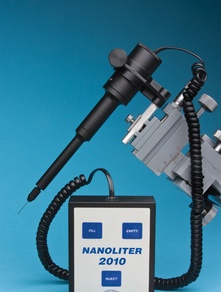/ Catalog / Microinjection and Perfusion Systems / Nanoliter 2010 Injector
Nanoliter 2010 Injector
This product is discontinued.High-precision piston micro-injector with adjustable speed and solution volume. Computer control is possible. Maximum fluid volume 5 ?µl, minimum 4.6 nl.
- Overview
- References
Features:
- Injector that is controlled by a microprocessor
- Direct piston displacement is used
- 23 nL/sec and 46 nL/sec for filling and injection, respectively
- Optional footswitch or controller
Injection Volumes
Direct piston displacement is used in the microprocessor-controlled Nanoliter 2010 from WPI. A calibrated volume will be smoothly injected by either pressing the injection button on the control box or the optional footswitch. The procedure is vibration-free and quiet. 23 nL/sec and 46 nL/sec are the capillary filling and injection rates, while 92 nL/sec and 230 nL/sec are the capillary emptying speeds. 5 µL of liquids can be ejected at the most. There is enough glass in each unit to pull at least 300 tips. Glass has a nominal 1.14 mm O.D. and 0.5 mm I.D. The injection volume can be adjusted using the DIP switch in 16 increments, ranging from 2.3 to 69.0 nL.Per filling, up to 100 injections may be started. The apparatus may inject from less than 1% to more than 10% of the total volume of the oocyte in one predetermined step increment, given that the volume of a normal Xenopus oocyte is approximately 500 nL.
Included with Pump
Included: 1 vial 3.5 in. capillaries (300); replacement "O" rings; Allen wrench; MicroFil™ MF34G backfilling needle; and two sample pre-pulled micropipettes.
Smart Controller
Up to four Nanoliter Injectors can have a "intelligent" and simple-to-use interface thanks to MICRO4, an optional microprocessor-based controller. The membrane keypad and LCD display are used to establish operating parameters. The user can synchronize the starting and stopping of a number of injectors, set the pump to infusion or withdrawal mode, enter the volume to be injected or withdrawn, and rate of delivery from the keypad. When the device is powered up, user parameters can be kept in its "non-volatile" memory for immediate retrieval. For "hands free" start/stop operation, a footswitch accessory can be inserted into a socket on the controller's back. The controller can be used with computer control software by connecting it to a computer using an RS-232 connector on the back of the device.
The instrument was used in these investigations:
- Using micro-injection technique to assess fungal toxicity in mosquito control.
Bawin, T., & Boukraa, S.
(2014) - Enhanced Infrared Neural Stimulation using Localized Surface Plasmon Resonance of Gold Nanorods.
Eom, K., Kim, J., Choi, J., Kang, T., & Chang, J.
(2014)


